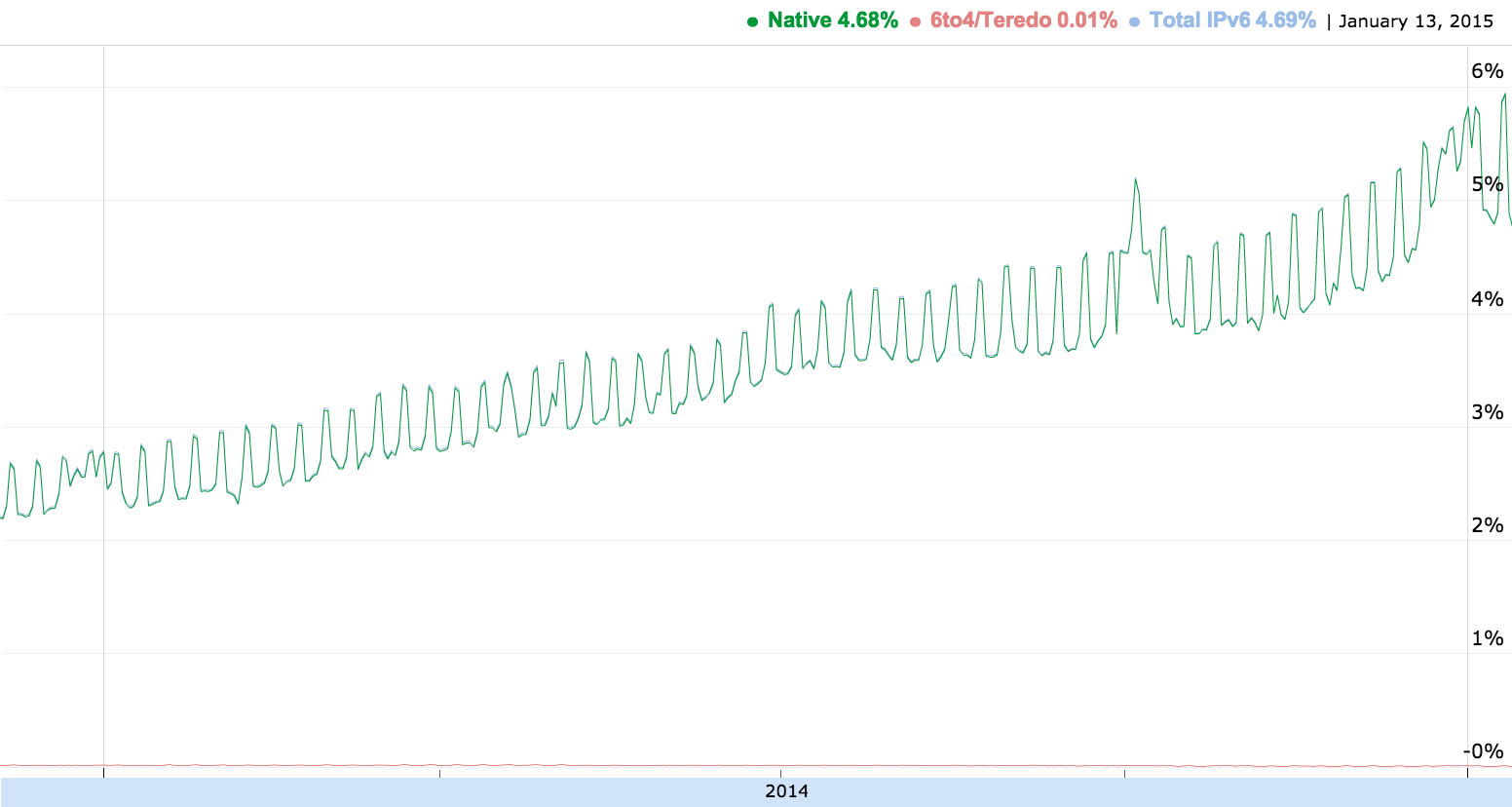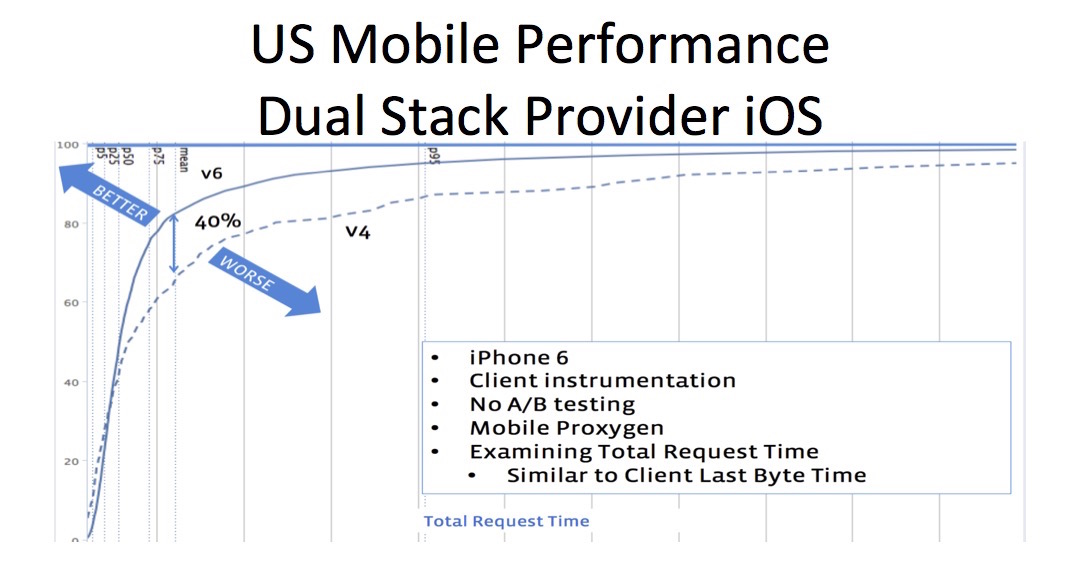
Ten years ago, I published my first "IPv4 address use report" over 2005. After that, I did 2006, 2007, 2008, 2009, and 2010. Today, I'm going back to the well one last time and provide an overview of what happened with the IPv4 addresses the past decade, which will close the book on the IPv4 address space as far as I'm concerned.
Read the article - posted 2015-01-01
Ten years ago, I published my first "IPv4 address use report" over 2005. After that, I did 2006, 2007, 2008, 2009, and 2010. Today, I'm going back to the well one last time and provide an overview of what happened with the IPv4 addresses the past decade, which will close the book on the IPv4 address space as far as I'm concerned.
At the end of 2005, 2056.30 million of the 3706.65 usable IPv4 addresses had been given out: 55%. Today, it's 3592.99 million, which is 97%. Can you imagine driving a car with a tank filled to 3%? Or work on a computer with a drive that's 97% full?
Read the article - posted 2015-01-08
After yesterday's final yearly IPv4 address report, I thought that today, I'd look at the other numbers the five Regional Internet Registries give out: IPv6 addresses and autonomous system (AS) numbers.
Read the article - posted 2015-01-09
Google has been measuring how many of its users have working IPv6 for some years now. At the beginning of 2014, this number was 2.75%; higher during weekends, lower on weekdays. We ended the year close to 6%, but then when we all went back to work in 2015, we dipped right back down below 5%!

When North Korea's connection to the global Internet stopped working last month, one particularly eye-popping detail emerged. Despite being home to 25 million people, the Hermit Kingdom has barely more than a thousand Internet protocol addresses. IP addresses are a bit like Social Security numbers, used to identify every device — from laptops to mobile phones to gaming systems — connected to the Internet. How many exist per person around the planet paints a picture of just how unevenly the Internet is distributed today.
Read the article - posted 2015-01-16
Today, I bought a new printer: a Canon PIXMA MG7550...
Read the article - posted 2015-03-03
Yesterday I wrote about my new printer, which supports IPv6. I posted a photo on Twitter with the printer's IPv6 address, and before long people attempted to print over the internet. Eventually, two succeeded.
I'm not very happy that Canon allows this by default, and doesn't give you any way to block this other than to disable IPv6 or put the printer behind a firewall.
Here's another link to that part of the story, as the title I used yesterday doesn't mention IPv6 or firewalling.
Read the article - posted 2015-03-04
As you may have noticed, I write about BGP from time to time. When coming up with example configurations, there's always the challenge of which AS numbers and IP addresses/prefixes to use...
Read the article - posted 2015-04-24
Earlier this month, RIPE Labs had a lengthy blog post about transfers of IPv4 addresses within the RIPE region. A lot of addresses went from Romania to Saudi Arabia, but the rest of Europe and the Middle East has been busy, too. However:
In the subsequent months of January 2015 through to April 2015, levels of transfer were significantly lower. Because the RIPE NCC listing service continues to show strong demand, the lower amounts transferred may well be a sign that the market in the RIPE region is capped by availability; total demand cannot be met by available supplies. This may change after the recently accepted RIPE policy for inter-RIR transfers has been implemented.
It probably wasn't an accident that two of the sponsors of the RIPE-70 meeting were businesses that facilitate IPv4 address trading.
Read the article - posted 2015-05-28
During last week's WWDC, Apple announced that it will start requiring iOS 9 apps to support IPv6. The reason for this is that cell carriers want to move from dual stack to IPv6-only cellular data service, with NAT64 to let users reach IPv4 destinations. This only works if apps use IPv6-compatible APIs and don't do things like checking for the availability of (IPv4) internet connectivity or using IPv4 addresses directly, rather than DNS names.
The article links to a WWDC video that explains all of this in detail, and then continues with some other very interesting information on network performance issues, including the fact that Apple is turning on Explicit Congestion Notification (ECN) in the new versions of MacOS and iOS. Microsoft tried to do the same thing in Vista, but had to turn it back off because too many firewalls blocked packets with ECN. Hopefully that's no longer an issue seven years later.
Read the article - posted 2015-06-16
At the NANOG meeting in San Francisco two weeks ago, there was a session on The benefits of deploying IPv6 only. Someone from T-Mobile explained that the latest Windows Mobile and Android support 464XLAT to allow IPv4-only applications to work over IPv6 with NAT64, so those devices now only get IPv6. Other devices only get IPv4, there's no dual stack. At that point, the panelists didn't know yet that Apple is requiring iOS 9 apps to work over IPv6 so those can work through NAT64 without 464XLAT.
Another interesting data point is the observation by Facebook that IPv6 tends to perform better than IPv4, with the margin being as large as 40%:

However, why this is is unclear: the RTTs are the same, yet the performance/bandwidth over IPv6 is better. There was some frustration because Apple's implementation of "happy eyeballs" only looks at the RTT to choose between IPv4 and IPv6, and thus lands on IPv4 a good deal of the time and doesn't enjoy the benefits of that better IPv6 performance.
Permalink - posted 2015-06-17
As we learned last month, Apple has included a DNS64/NAT64 implementation in the upcoming version 10.11 of the Mac operating system, for the purpose of testing whether iOS applications are "IPv6-clean". I installed the public beta of 10.11 last week, so I was able to see how this DNS64/NAT64 implementation works.
Read the article - posted 2015-07-13